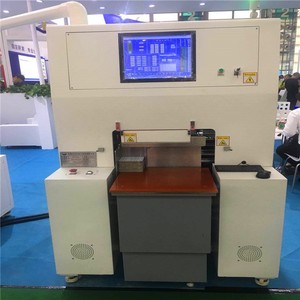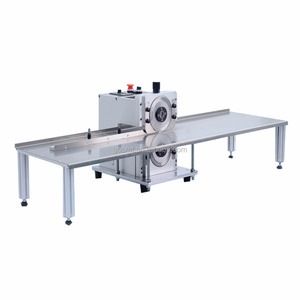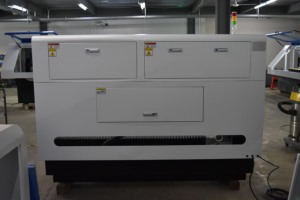Types of PCB V scoring machines
A PCB V scoring machine is used to cut and groove PCBs along prescribed lines. It is an integral part of the PCB assembly process. The machine works by creating a V-shaped groove on the PCB. The groove makes it easier to break the board along specified lines neatly and precisely. Several types of V-scoring machines are available for different industrial needs.
- Manual PCB V scoring machine: This manual PCB V scorer has a sturdy base, a cutting blade, and a scoring guide. Operators can clamp the PCB onto the base, align it with the scoring guide, and manually push the board to score it with a cutting blade. The manual scorer is small and cost-effective, but it does not provide precise cuts.
- Semiautomatic PCB V scoring machine: The semiautomatic PCB scorer requires some manual effort, but it is operated with additional tools. This machine has a scoring knife, manual loading, control PLC, and electrical components. The operator loads the PCB, and the device uses PLC and electrical components to perform the scoring function.
- Automatic PCB V scoring machine: In an automatic scoring machine, the manual effort required is minimal. It consists of a scoring blade and controller. The PCB is loaded into the machine and precisely scored using the controller. This machine has the highest production rate among all the scoring machines. However, it is also the most expensive option available.
- Laser PCB V cutting machine: In this machine, a laser is used to cut the PCB. Laser cutters provide accurate cutting with a smooth finish. This means they do not require any additional routing or processing after cutting. The laser machine also provides flexible cutting paths and can cut complex shapes and designs.
- Router-based PCB V cutting machine: This machine uses a router to score the PCB. The router cuts along the preset lines with high precision. It also offers manufacturing flexibility and can make multiple shapes and patterns with ease.
Many types of machines are available based on the level of automation. For example, there are stand-alone, manual, and router-based PCB cutting machines. The manual and stand-alone machines are more conventional, while the router-based machine has technological advancement and offers more flexibility and precision.
Specifications and maintenance of the PCB V scoring machine
The specifications of a PCB V-scoring machine may vary from one model to another. However, some key features are usually standard and are as follows.
-
Length x width x height
Usually, the overall dimensions of the machine will vary upon whether it is an automatic or manual machine. For example, a typical manual V-scoring machine might have overall dimensions of 1280 mm x 900 mm x 1300 mm. An automatic V-scoring machine might have dimensions of 1800 mm x 1260 mm x 1610 mm.
-
Board Thickness
The thickness of the PCB board that can be cut varies for different machines. Most machines can cut PCBs with a thickness of 0.5mm–3.5mm.
-
Scoring Blade
The main blade in the machine is known as the scoring blade, which is used to cut along the scored lines. It usually comes in a length of 400mm and a cutting width of 3mm, but this can vary depending on the PCB design requirements.
-
Cutting Precision
The machine is designed to accurately cut scored lines on a PCB within ±0.2mm. This level of precision ensures that the individual PCB units are consistent and uniform, allowing for easy assembly and reliable performance.
-
Working Speed
In the case of automatic V-scoring machines, the working speed is an essential specification. While a manual machine might take a long time and only produce around 1000 pieces in one day, an automatic machine can have a working speed of 1500-3000 pieces in a single day. The working speed of the machine will determine how efficiently it can process PCBs.
Maintaining a PCB V-scoring machine is crucial to ensuring its longevity, reliability, and optimal performance. Like any other machine, maintenance and care of the machine ensures it functions properly and efficiently. Neglecting the machine may result in breakdown and damages.
It may be helpful to follow a regular maintenance schedule. Daily and weekly, checks and parts to be cleaned are as follows. The entire machine should be cleaned of any dust or debris after any cutting operation. In addition, the following parts may be cleaned weekly.
- The conveyor belt should be wiped with a damp cloth to remove any oily or sticky substances and cleaned with a soft brush.
- The blade can be cleaned gently with a soft brush to remove any residual material or dust. It should be inspected for wear and damage and lightly lubricated with machine oil before replacing it.
- The vacuum system filters should be removed and cleaned with compressed air.
- The inspection tables should be cleaned to remove any glass fiber dust or debris to ensure no rubbish is left on the PCB before the next step.
Once a month, more in-depth maintenance tasks may include the following:
- Lubricating the machine's moving parts helps to reduce friction and joint wear.
- Vacuum pump maintenance includes changing the filters and inspecting the pump for required maintenance or cleaning.
- Calibration of the scoring blade may be required if it is not aligned properly after replacing it or if the machine has not been used for an extended period.
- Removing any glass fiber dust from hepa filters in the extraction system is also essential to ensure that the machine functions properly.
Finally, a thorough inspection of all critical components will ensure that any issues are detected early and rectified before they cause any further damage.
Uses of PCB V scoring machine
The PCB V scoring machines are widely used in the electronics, LED lighting, home appliance, and automotive parts industries to manufacture the following products:
- Circuit Boards: The primary use of a PCB V scoring machine is to score light guides used in LCD backlights. Other applications are in V-cutting circuit boards, polymer-mixed material backlights, and other light guides.
- Displays, Signage, and Television Components: PCB V scoring machines are used to cut precise grooves in light guide boards, which are essential components of LCD (Liquid Crystal Display)Television sets.
- Lamps and Tube Light Components: In the realm of lighting, PCB V scoring machines are employed to create light guide PCBs used in bulb lamps and tube lightPCBs. These light guide PCBs play a crucial role in efficiently directing and spreading light to achieve the desired luminosity and beam patterns in bulb and tube lighting products.
- Smart Home Products: In smart home products, a PCB V scoring machine is used to fabricate light guide PCBs for smart indicators. These light guide PCBs are designed to visually convey information about the status or functioning of the smart home device, such as the device being powered on, connected to a network, or experiencing an alert. The design of the light guide PCB allows for the proper dispersion and projection of light, typically from an LED, to create these informative indicators.
- Automotive Dashboard and Indicator Lights: In the automotive industry, the PCB V scoring machine is used to produce light guide PCBs for dashboard and indicator lights. The dashboard lights serve as functional indicators to convey critical information to the driver, such as the vehicle's status, speed, fuel level, engine temperature, and other important parameters. The indicator lights, on the other hand, signify various functions such as turn signals, high beams, engine alerts, and other notifications.
How to choose a PCB V scoring machine
There are quite a number of factors that should be considered when looking to buy a PCB V scoring machine. Focusing on the key parameters for selecting the machine will help customers to make a better and informed purchasing decision.
- Scoring patterns and flexibility: Choose the machine that offers various scoring patterns and the ability to customize the V-score design for specificPCB configurations. This is very important if the buyer is looking to apply the machine for differentPCB projects or if there is a need to meet distinct client specifications. Flexibility in scoring patterns can enhance the quality and efficiency ofPCB assembly.
- Depth control and accuracy: It's essential to select a PCB V scoring machine that has precise depth control and scoring accuracy. Accurate depth control ensures that the scoring only goes through thePCB outer layers and not into the inner routing layers. This helps to maintain the integrity of thePCB material.
- Production speed: Consider the production speed of the machine in relation to the intendedPCB assembly volume. Choose a machine with an optimal scoring speed that matches the required production rate. This helps to increase the overall efficiency of theAssembly process while meeting production targets.
- Material compatibility: Different PCB scoring machines are compatible with other materials. When choosing a V-scoring machine, it is crucial to ensure that it is compatible with thePCB materials. This includes checking the machine's scoring blades or tools to avoid any unnecessary delay and set up time during the assembly process.
- Automation and workflow integration: Consider the machine's automation level and ability to integrate into the existingAssembly workflow. Select a machine that offers automation features such as automated loading/unloading, scoring control systems, and other workflow integration capabilities. This helps to streamline theAssembly process while reducing manual intervention.
- Operator-friendly design: Finally, it is important to choose a machine with an operator-friendly design. Such a machine will have intuitive controls, simple setup procedures, and a scoring interface. Investing in a machine with an operator-friendly design helps to minimize the time needed for training and enhances the overall productivity of theAssembly team.
Pcb v scoring machine faq
Q1: What is the difference between V-scoring and laser cutting for PCBs?
A1: The V-score cutting machine is designed to create grooves in the substrate of circuit boards to facilitate controlled breaking along specific lines. On the other hand, laser cutting can precisely cut shapes and sizes into the circuit board material without the need for creating grooves first.
Q2: What is the maximum PCB thickness for V-scoring?
A2: Typically, PCBs with a maximum thickness of up to 2.5mm can be V-scored. However, the maximum thickness might vary depending on the machine's specifications and the scoring methods used.
Q3: Can V-scoring handle multiple PCB designs on one panel?
A3: Yes, V-scoring is particularly well-suited for panelizing PCBs with multiple designs on one panel. It allows for efficient processing of several circuits simultaneously, reducing production time and costs.
Q4: What materials can be V-scored besides PCBs?
A4: In addition to circuit boards, the V-scoring technique can also be used to score other materials. Such materials include acrylic, polycarbonate, melamine-coated particleboard, composites, styrene, ABS, and any other material with an easily scoreable composition.
Q5: What are the signs that a V-score machine needs maintenance?
A5: Some of the signs indicating that the V-score machine may need some maintenance include scoring inconsistencies or irregularities, loss of cutting precision, increased braking or stopping time, unusual noises or vibrations. It is also important to regularly check the machine's components for any signs of wear or damage.















































































































































































































